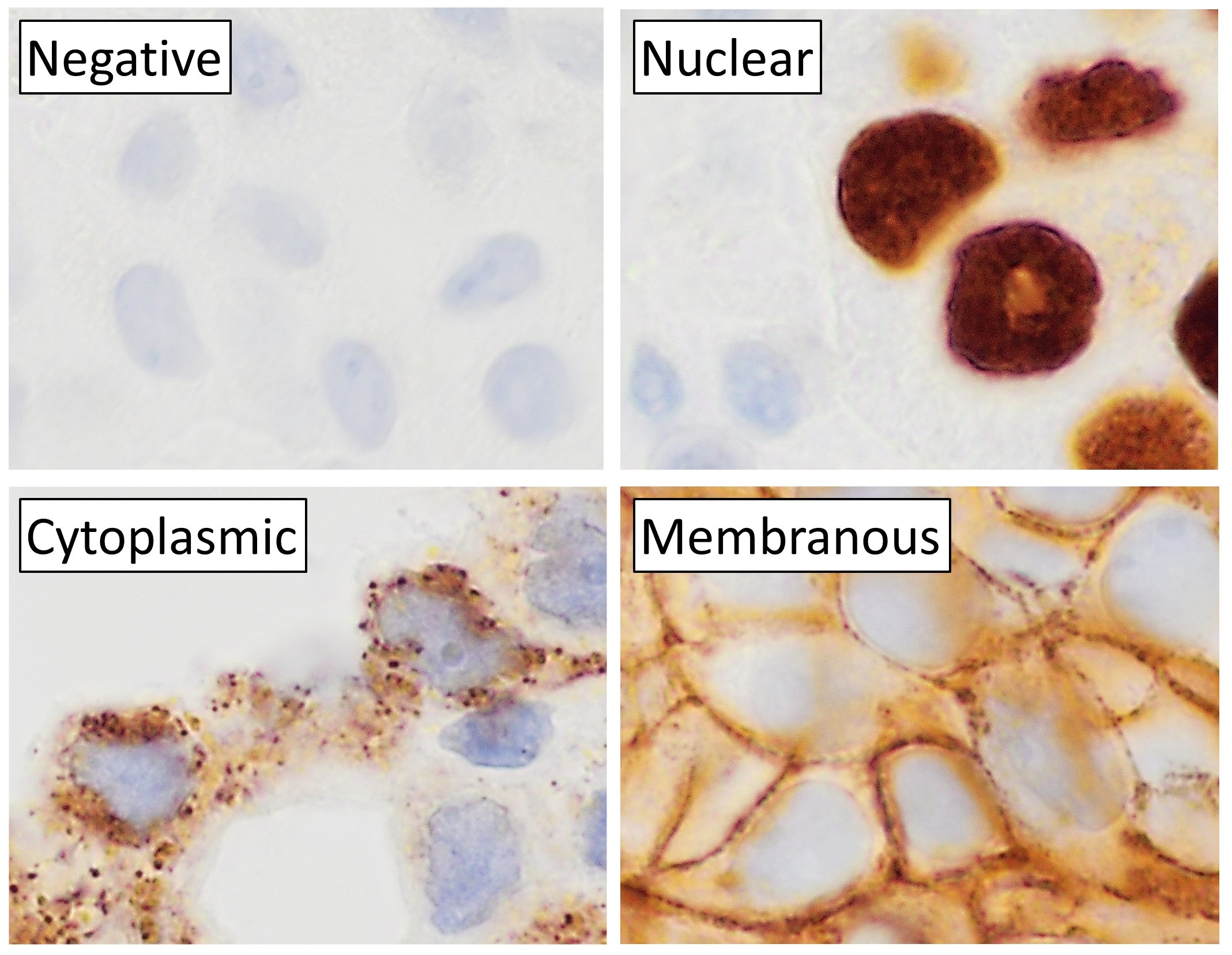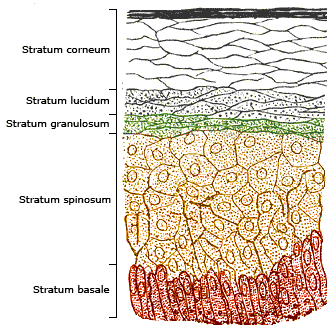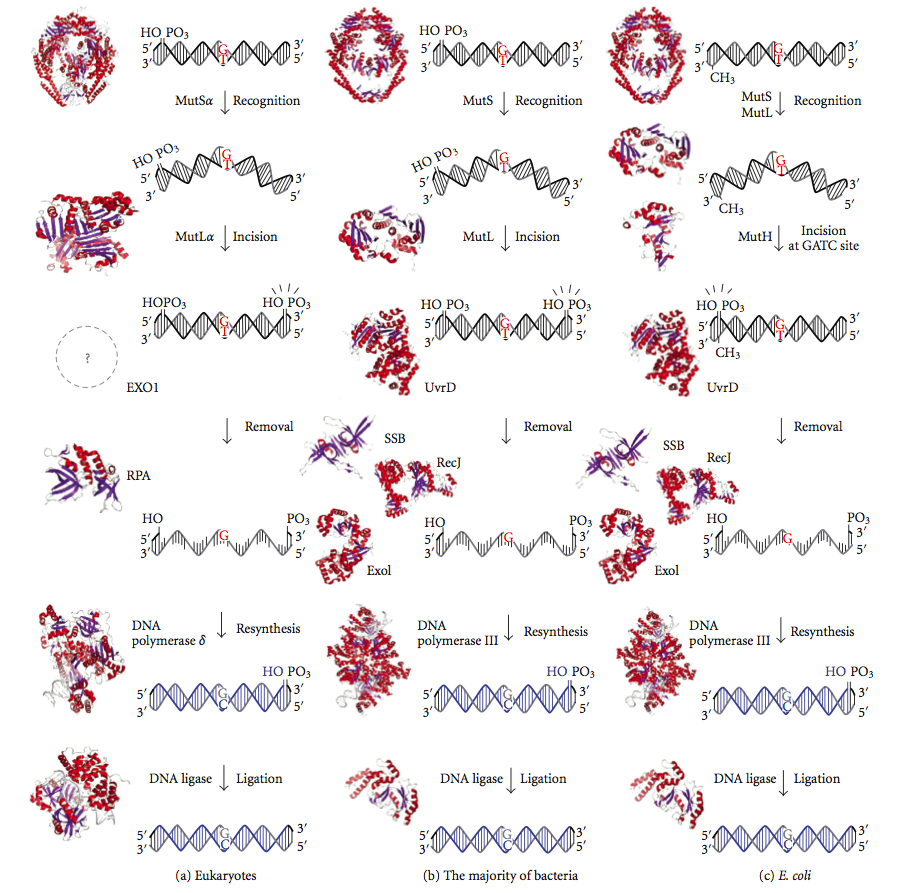|
Muir–Torre Syndrome
Muir–Torre syndrome is a rare hereditary, autosomal dominant cancer syndrome that is thought to be a subtype of HNPCC (Lynch syndrome). Individuals are prone to develop cancers of the colon, genitourinary tract, and skin lesions, such as keratoacanthomas and Sebaceous carcinoma, sebaceous tumors. The genes affected are MLH1, MSH2, and more recently, MSH6, and are involved in DNA mismatch repair. Symptoms Muir–Torre syndrome is characterized by both: # At least a single sebaceous gland tumor (either an adenoma, an epithelioma, or a carcinoma) # A minimum of one internal malignancy The Amsterdam criteria are frequently used to diagnose Lynch syndrome and Muir–Torre syndrome. They include the following: * 3 or more relatives with an HNPCC-associated cancer (i.e., colorectal, cancer of the endometrium, small bowel, ureter, or renal pelvis) * 2 or more successive generations affected by cancer * 1 or more persons with cancer is a first-degree relative of the other 2, at least ... [...More Info...] [...Related Items...] OR: [Wikipedia] [Google] [Baidu] |
Micrograph
A micrograph is an image, captured photographically or digitally, taken through a microscope or similar device to show a magnify, magnified image of an object. This is opposed to a macrograph or photomacrograph, an image which is also taken on a microscope but is only slightly magnified, usually less than 10 times. Micrography is the practice or art of using microscopes to make photographs. A photographic micrograph is a photomicrograph, and one taken with an electron microscope is an electron micrograph. A micrograph contains extensive details of microstructure. A wealth of information can be obtained from a simple micrograph like behavior of the material under different conditions, the phases found in the system, failure analysis, grain size estimation, elemental analysis and so on. Micrographs are widely used in all fields of microscopy. Types Photomicrograph A light micrograph or photomicrograph is a micrograph prepared using an optical microscope, a process referred to ... [...More Info...] [...Related Items...] OR: [Wikipedia] [Google] [Baidu] |
Immunohistochemistry
Immunohistochemistry is a form of immunostaining. It involves the process of selectively identifying antigens in cells and tissue, by exploiting the principle of Antibody, antibodies binding specifically to antigens in biological tissues. Albert Coons, Albert Hewett Coons, Ernst Berliner, Ernest Berliner, Norman Jones and Hugh J Creech was the first to develop immunofluorescence in 1941. This led to the later development of immunohistochemistry. Immunohistochemical staining is widely used in the diagnosis of abnormal cells such as those found in cancerous tumors. In some cancer cells certain tumor antigens are expressed which make it possible to detect. Immunohistochemistry is also widely used in basic research, to understand the distribution and localization of biomarkers and differentially expressed proteins in different parts of a biological tissue. Sample preparation Immunohistochemistry can be performed on tissue that has been fixed and embedded in Paraffin wax, paraffin, ... [...More Info...] [...Related Items...] OR: [Wikipedia] [Google] [Baidu] |
Epidermal Nevi, Neoplasms, And Cysts
The epidermis is the outermost of the three layers that comprise the skin, the inner layers being the dermis and hypodermis. The epidermal layer provides a barrier to infection from environmental pathogens and regulates the amount of water released from the body into the atmosphere through transepidermal water loss. The epidermis is composed of multiple layers of flattened cells that overlie a base layer (stratum basale) composed of columnar cells arranged perpendicularly. The layers of cells develop from stem cells in the basal layer. The thickness of the epidermis varies from 31.2μm for the penis to 596.6μm for the sole of the foot with most being roughly 90μm. Thickness does not vary between the sexes but becomes thinner with age. The human epidermis is an example of epithelium, particularly a stratified squamous epithelium. The word epidermis is derived through Latin , itself and . Something related to or part of the epidermis is termed epidermal. Structure Cell ... [...More Info...] [...Related Items...] OR: [Wikipedia] [Google] [Baidu] |
List Of Cutaneous Conditions Associated With Increased Risk Of Nonmelanoma Skin Cancer
There are several conditions of or affecting the human integumentary system that are associated with an increased risk of developing nonmelanoma skin cancer (i.e. squamous-cell carcinoma and basal-cell carcinoma). See also * List of cutaneous conditions * List of contact allergens * List of cutaneous conditions associated with internal malignancy * List of cutaneous conditions caused by mutations in keratins * List of cutaneous conditions caused by problems with junctional proteins * List of genes mutated in cutaneous conditions * List of histologic stains that aid in diagnosis of cutaneous conditions * List of immunofluorescence findings for autoimmune bullous conditions * List of inclusion bodies that aid in diagnosis of cutaneous conditions * List of keratins expressed in the human integumentary system There are many different keratin proteins normally expressed in the human integumentary system. See also * List of cutaneous conditions caused by mutation ... [...More Info...] [...Related Items...] OR: [Wikipedia] [Google] [Baidu] |
List Of Cutaneous Conditions
Many skin conditions affect the human integumentary system—the organ system covering the entire surface of the Human body, body and composed of Human skin, skin, hair, Nail (anatomy), nails, and related muscle and glands. The major function of this system is as a barrier against the external environment. The skin weighs an average of four kilograms, covers an area of two square metres, and is made of three distinct layers: the epidermis (skin), epidermis, dermis, and subcutaneous tissue. The two main types of human skin are: glabrous skin, the hairless skin on the palms and soles (also referred to as the "palmoplantar" surfaces), and hair-bearing skin.Burns, Tony; ''et al''. (2006) ''Rook's Textbook of Dermatology CD-ROM''. Wiley-Blackwell. . Within the latter type, the hairs occur in structures called pilosebaceous units, each with hair follicle, sebaceous gland, and associated arrector pili muscle. Embryology, In the embryo, the epidermis, hair, and glands form from the ectod ... [...More Info...] [...Related Items...] OR: [Wikipedia] [Google] [Baidu] |
Henry T
Henry may refer to: People and fictional characters * Henry (given name), including lists of people and fictional characters * Henry (surname) * Henry, a stage name of François-Louis Henry (1786–1855), French baritone Arts and entertainment * ''Henry'' (2011 film), a Canadian short film * ''Henry'' (2015 film), a virtual reality film * '' Henry: Portrait of a Serial Killer'', a 1986 American crime film * ''Henry'' (comics), an American comic strip created in 1932 by Carl Anderson * "Henry", a song by New Riders of the Purple Sage Places Antarctica * Henry Bay, Wilkes Land Australia * Henry River (New South Wales) * Henry River (Western Australia) Canada * Henry Lake (Vancouver Island), British Columbia * Henry Lake (Halifax County), Nova Scotia * Henry Lake (District of Chester), Nova Scotia New Zealand * Lake Henry (New Zealand) * Henry River (New Zealand) United States * Henry, Illinois * Henry, Indiana * Henry, Nebraska * Henry, South Dakota * Henry Co ... [...More Info...] [...Related Items...] OR: [Wikipedia] [Google] [Baidu] |
Douglas P
Douglas Pearce (born 27 April 1956), known professionally as Douglas P., is a British musician, best known for his neofolk project Death in June. He was born in Sheerwater in Woking, Surrey and lives in Australia, which has been his home since the mid-1990s. Early life Pearce was born on 27 April 1956 and grew up in Sheerwater, a suburb of Woking in Surrey which he said was a "white, working-class ghetto"; his father worked as a courier for the military and had served in World War II. Both of his parents were English, though his mother claimed Scots-Irish ancestry. His father died of a heart attack at age 56, when Pearce was 14. He grew up in what he describes as "a very militaristic environment, surrounded by war"; he says that he "had a natural attraction to war". At the age of 18 Pearce left home, went hitchhiking around Europe and "came home a changed man". As a child, Pearce was exorcised by his parents for alleged demonic possession, and after his father died, h ... [...More Info...] [...Related Items...] OR: [Wikipedia] [Google] [Baidu] |
Edward Grainger Muir
Sir Edward Grainger Muir (18 February 1906 – 14 October 1973), was a British pathologist and colorectal surgeon. He was a recipient of the Broderip scholarship of the Middlesex Hospital and later held appointments at King's College Hospital, the Queen Victoria Hospital, and the King Edward VII's Hospital for Officers, where he was on the list of honorary medical staff. He was president of the Royal College of Surgeons, the Medical Society of London, the Harveian Society, and of the Proctological Section and Section of Surgery of the Royal Society of Medicine, London. Muir was appointed surgeon to the British Royal Household in 1954, and surgeon to the Queen in 1964. Shortly before his death he was made Serjeant Surgeon. He was knighted in 1970. Muir–Torre syndrome Muir–Torre syndrome is a rare hereditary, autosomal dominant cancer syndrome that is thought to be a subtype of HNPCC (Lynch syndrome). Individuals are prone to develop cancers of the colon, genitourinary tr ... [...More Info...] [...Related Items...] OR: [Wikipedia] [Google] [Baidu] |
Isotretinoin
Isotretinoin, also known as 13-''cis''-retinoic acid and sold under the brand name Accutane among others, is a medication used to treat skin diseases like harlequin-type ichthyosis, and lamellar ichthyosis, and severe cystic acne or moderate acne that is unresponsive to antibiotics. Isotretinoin is used off-label to treat basal cell carcinoma and squamous cell carcinoma, although clinical evidence suggests it is not effective in this setting. It is a retinoid, meaning it is related to vitamin A, and is found in small quantities naturally in the body. Its isomer, tretinoin, is also an acne drug. The most common adverse effects are dry lips ( cheilitis), dry and fragile skin ( xeroderma), dry eyes and an increased susceptibility to sunburn. Uncommon and rare side effects include muscle aches and pains ( myalgias), and headaches. Some of those side effects can persist long after the discontinuation of the use of the drug. Isotretinoin may cause liver failure, therefore th ... [...More Info...] [...Related Items...] OR: [Wikipedia] [Google] [Baidu] |
DNA Mismatch Repair Proteins
DNA mismatch repair (MMR) is a system for recognizing and repairing erroneous insertion, deletion, and mis-incorporation of bases that can arise during DNA replication and recombination, as well as repairing some forms of DNA damage. Mismatch repair is strand-specific. During DNA synthesis the newly synthesised (daughter) strand will commonly include errors. In order to begin repair, the mismatch repair machinery distinguishes the newly synthesised strand from the template (parental). In gram-negative bacteria, transient hemimethylation distinguishes the strands (the parental is methylated and daughter is not). However, in other prokaryotes and eukaryotes, the exact mechanism is not clear. It is suspected that, in eukaryotes, newly synthesized lagging-strand DNA transiently contains nicks (before being sealed by DNA ligase) and provides a signal that directs mismatch proofreading systems to the appropriate strand. This implies that these nicks must be present in the leading ... [...More Info...] [...Related Items...] OR: [Wikipedia] [Google] [Baidu] |
Immunohistochemistry
Immunohistochemistry is a form of immunostaining. It involves the process of selectively identifying antigens in cells and tissue, by exploiting the principle of Antibody, antibodies binding specifically to antigens in biological tissues. Albert Coons, Albert Hewett Coons, Ernst Berliner, Ernest Berliner, Norman Jones and Hugh J Creech was the first to develop immunofluorescence in 1941. This led to the later development of immunohistochemistry. Immunohistochemical staining is widely used in the diagnosis of abnormal cells such as those found in cancerous tumors. In some cancer cells certain tumor antigens are expressed which make it possible to detect. Immunohistochemistry is also widely used in basic research, to understand the distribution and localization of biomarkers and differentially expressed proteins in different parts of a biological tissue. Sample preparation Immunohistochemistry can be performed on tissue that has been fixed and embedded in Paraffin wax, paraffin, ... [...More Info...] [...Related Items...] OR: [Wikipedia] [Google] [Baidu] |
Turcot Syndrome
Mismatch repair cancer syndrome (MMRCS) is a cancer syndrome associated with biallelic DNA mismatch repair mutations. It is also known as Turcot syndrome (after Jacques Turcot, who described the condition in 1959) and by several other names. In MMRCS, neoplasia typically occurs in both the gut and the central nervous system (CNS). In the large intestine, multiple colonic polyps develop; in the CNS, brain tumors. Presentation Genetics Under the name constitutional mismatch repair-deficiency (CMMR-D), it has been mapped to MLH1, MSH2, MSH6 or PMS2. Monoallelic mutations of these genes are observed in the condition known as Lynch syndrome or hereditary nonpolyposis colorectal cancer, while biallelic mutations are observed in CMMR-D. People expressing the HNPCC (which itself is considered autosomal dominant) trait are considered carriers of CMMR-D, thus CMMR-D is classified as autosomal recessive. The term "childhood cancer syndrome" has also been proposed. Café-au-lait macules ... [...More Info...] [...Related Items...] OR: [Wikipedia] [Google] [Baidu] |




